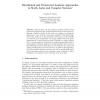Free Online Productivity Tools
i2Speak
i2Symbol
i2OCR
iTex2Img
iWeb2Print
iWeb2Shot
i2Type
iPdf2Split
iPdf2Merge
i2Bopomofo
i2Arabic
i2Style
i2Image
i2PDF
iLatex2Rtf
Sci2ools
EEF
2000
2000
Distributed and Structured Analysis Approaches to Study Large and Complex Systems
Both the logic and the stochastic analysis of discrete-state systems are hindered by the combinatorial growth of the state space underlying a high-level model. In this work, we consider two orthogonal approaches to cope with this "state-space explosion". Distributed algorithms that make use of the processors and memory overall available on a network of N workstations can manage models with state spaces approximately N times larger than what is possible on a single workstation. A second approach, constituting a fundamental paradigm shift, is instead based on decision diagrams and related implicit data structures that efficiently encode the state space or the transition rate matrix of a model, provided that it has some structure to guide its decomposition; with these implicit methods, enormous sets can be managed efficiently, but the numerical solution of the stochastic model, if desired, is still a bottleneck, as it requires vectors of the size of the state space.
| Added | 24 Aug 2010 |
| Updated | 24 Aug 2010 |
| Type | Conference |
| Year | 2000 |
| Where | EEF |
| Authors | Gianfranco Ciardo |
Comments (0)

